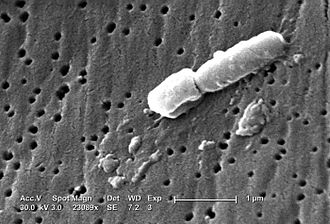Conditionally pathogenic enterobacteria
Among the medically important species of conditionally pathogenic enterobacteria, we include the genera Escherichia, Klebsiella, Enterobacter, Serratia, Citrobacter, which can be summarized under the name coliform bacilli and related genera Proteus, Morganella, Providencia. They are facultatively anaerobic gram-negative rods. They are catalase-positive and oxidase-negative. They reduce nitrates, ferment sugars, do not form spores. With the exception of Klebsiella, they are able to move with peritricheal flagella. Klebsiella are also the only representatives of this category that form shells, other genera do so only very rarely. They commonly occur in the environment and are part of the physiological intestinal flora. They have a complex antigenic structure, on which the pathogenicity of each serovar is based. They are classified by more than 150 different thermostable O antigens, more than 100 thermolabile K antigens, and about 50 H antigens. These bacteria are able to cause intestinal and extraintestinal diseases, most often in the urinary system.
Escherichia spp.[edit | edit source]
The genus Escherichia includes a total of 8 specified species. The most medically discussed species is Escherichia coli. It is a common member of the physiological intestinal flora. It also occurs in small amounts as part of the physiological flora in the upper respiratory tract and genitals. It usually does not cause disease (in case it stays within its normal boundaries), only certain serovars are pathogenic. It typically causes urinary tract infections. E. coli are said to be the most common pathogen in this area. Regarding extraintestinal infections, it is also responsible for meningitis, pneumonia, cholecystitis, appendicitis, peritonitis, postoperative wound infections, and sepsis. It is often nosocomial in nature. Intestinal infections are caused by strains EPEC (enteropathogenic), ETEC (enterotoxigenic), EIEC (enteroinvasive), EHEC (enterohemorrhagic). Each of these named strains has a different mechanism of pathogenicity. However, everyone must be able to adhere to intestinal cells and some produce toxins. EPEC adheres tightly to the intestinal cells and causes changes in the intestinal cell, the most significant of which is the loss of microvilli. Sometimes it penetrates the cells. It causes severe watery diarrhea in children. It is more of a problem in developing countries. ETECs produce LT (thermolabile) or ST (thermostable) enterotoxins. Many serovars produce both types of enterotoxin, logically causing an even more severe course of the disease. It is a common cause of traveler's diarrhea. EIEC penetrates the intestinal cells, where it causes an inflammatory lesion. The disease mainly affects children in developing countries and tourists. What remains is EHEC, enterohemorrhagic also Shiga-like toxigenic, verotoxigenic E. coli. It poses the greatest threat of these phyla. It can cause hemorrhagic diarrhea, as well as a hemolytic uraemic syndrome (HUS). Lethality depends on the patient's age and virulence of the given serovar, it reaches up to 10% in E. coli type O157:H-, of which the strongest association with HUS has the type O157: H7. It is also dangerous in that it spreads easily. This is evidenced by the case of the EHEC 0104: H4 epidemic of 2011 in Northern Germany. At that time, more than 3,800 cases were recorded, 54 people died.
Klebsiella spp.[edit | edit source]
The genus Klebsiella is now defined by ten species. It differs from other enterobacteria in that it regularly forms enclosures and is immobile. The most important pathogen of this genus is undoubtedly Klebsiella pneumoniae. It lives in the intestine, in the oral cavity, in the upper respiratory tract, on the surface of the skin, and also in the surrounding environment. It causes pneumonia and urinary tract infections, especially in debilitated patients in hospitals. Here, it can also become a source of infection for newborns, causing meningitis and sepsis.
Enterobacter, Serratia, Citrobacter spp.[edit | edit source]
Enterobacter, Serratia, and Citrobacter are more commonly occurring as infections in hospitals. They attack bedsores and the respiratory and urogenital systems. They tend to be resistant to common antibiotics, thus in hospitals, there is a possibility of transmitting genetic information of resistance to ATB, e.g., to Klebsiella. Enterobacter and Serratia are related to Klebsiella, Citrobacter, Salmonella. Overall, however, they have low pathogenicity. The medically important are Enterobacter cloacae, Enterobacter aerogenes, Enterobacter sakazakii, Citrobacter freundii, Citrobacter koseri, Serratia marcescens.
Proteus, Morganella, Providencia spp.[edit | edit source]
The genera Proteus, Morganella, Providencia have a lot of identical properties. They are characterized by a typical urea odor on the cultivation soils. They are a common part of the intestine and can be found in the surroundings. Infections are usually caused endogenously. Their pathogenicity is low. In healthy individuals, they are able to cause at most infections of the urinary system, in the weak, on the other hand, it causes pneumonia, meningitis or sepsis. Species that cause these diseases include Proteus mirabilis, Proteus vulgaris, Morganella morganii, Providencia stuartii, Providencia rettgeri.
Links[edit | edit source]
Related articles[edit | edit source]
References[edit | edit source]
- BENEŠ, Jiří. Infekční lékařství. 1. edition. Galén, 2009. 651 pp. ISBN 978-80-7262-644-1.
- BEDNÁŘ, Marek – SOUČEK, Andrej – FRAŇKOVÁ, Věra. Lékařská mikrobiologie : Bakteriologie, virologie, parazitologie. 1. edition. Praha : Marvil, 1996. 558 pp. ISBN 8023802976.
- CAREY, Roberta B – SCHUSTER, Mindy Gail. Lékařská mikrobiologie v klinických případech. 1. edition. Praha : Triton, 2011. 321 pp. ISBN 978-80-7387-480-3.


